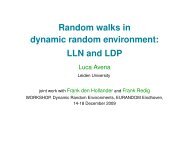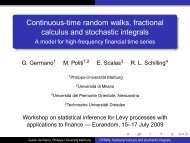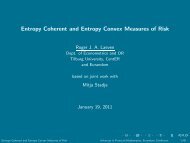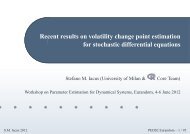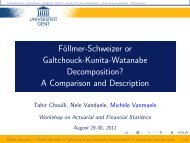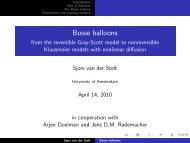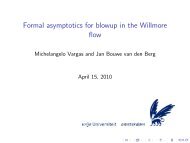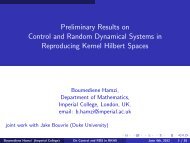presentation - Eurandom
presentation - Eurandom
presentation - Eurandom
You also want an ePaper? Increase the reach of your titles
YUMPU automatically turns print PDFs into web optimized ePapers that Google loves.
12<br />
STW-project Effective Process Time:<br />
an overview<br />
Ivo Adan, Onno Boxma, Pascal Etman, Ad Kock,<br />
Erjen Lefeber, Koos Rooda, Marcel van Vuuren<br />
Department of Mechanical Engineering &<br />
Department of Mathematics and Computer Science<br />
Eindhoven University of Technology<br />
<strong>Eurandom</strong> workshop June 19-20th 2006 Eindhoven<br />
◭◭◭◮◮◮ 1/25
Contents<br />
Introduction<br />
EPT concept<br />
Research project<br />
Progress<br />
Application<br />
12Contents<br />
• Introduction<br />
• Effective process time concept<br />
• STW project<br />
• Progress<br />
• Application<br />
◭◭◭◮◮◮ 2/25
Contents<br />
Introduction<br />
EPT concept<br />
Research project<br />
Progress<br />
Application<br />
12Introduction<br />
◭◭◭◮◮◮ 3/25
Contents<br />
Introduction<br />
EPT concept<br />
Research project<br />
Progress<br />
Application<br />
12Motivation<br />
Performance analysis of manufacturing systems.<br />
◭◭◭◮◮◮ 4/25
Contents<br />
Introduction<br />
EPT concept<br />
Research project<br />
Progress<br />
Application<br />
12Motivation<br />
Performance analysis of manufacturing systems<br />
◭◭◭◮◮◮ 5/25
Contents<br />
Introduction<br />
EPT concept<br />
Research project<br />
Progress<br />
Application<br />
12Models<br />
of manufacturing systems<br />
Performance measures:<br />
• Throughput δ<br />
• Flow time ϕ<br />
• Work-in-process w<br />
Shopfloor realities:<br />
• Machine downs, repairs, setup, product mix,<br />
operators, batching, product recipes, priority lots, . . .<br />
Modeling approaches:<br />
• Queueing (network) analysis (exact/approximation)<br />
• Discrete-event simulation<br />
◭◭◭◮◮◮ 6/25
Contents<br />
Introduction<br />
EPT concept<br />
Research project<br />
Progress<br />
Application<br />
12Models<br />
of manufacturing systems<br />
Queueing (network) analysis (exact/approximation):<br />
• Computationally efficient: ideal for what-if and<br />
optimization studies<br />
• Limited applicability due to restrictive assumptions<br />
regarding shopfloor realities<br />
Discrete-event simulation:<br />
• Shopfloor realities may be modeled in detail<br />
• Computationally intensive<br />
Model parameters:<br />
• Can we obtain all required data to set the model<br />
parameters?<br />
◭◭◭◮◮◮ 7/25
Contents<br />
Introduction<br />
EPT concept<br />
Research project<br />
Progress<br />
Application<br />
12EPT<br />
concept<br />
◭◭◭◮◮◮ 8/25
Contents<br />
Introduction<br />
EPT concept<br />
Research project<br />
Progress<br />
Application<br />
12Example:<br />
a production flow line<br />
Station 1<br />
Flowline characterisics:<br />
Station 2<br />
Station 3<br />
• Infinite buffers, single-server stations, single-lot<br />
machines.<br />
Shopfloor realities:<br />
• Process mix, setup-times, recipes, operator<br />
Station 4<br />
availability, machine downs, repair,rework, hot-lots,<br />
sequencing, scheduling, shopfloor control, ...<br />
◭◭◭◮◮◮ 9/25
Contents<br />
Introduction<br />
EPT concept<br />
Research project<br />
Progress<br />
Application<br />
12Zooming<br />
in: single-server workstation<br />
arrival<br />
queueing<br />
Reality: Natural processing<br />
processing<br />
departure<br />
◭◭◭◮◮◮ 10/25<br />
M<br />
Random failures (preemptive): e.g. machine downs<br />
Planned process delays (non-preemptive): e.g. setups<br />
Aggregation: Effective process time<br />
Queueing model: CT = c2 a +c 2 e<br />
2<br />
[Hopp, Spearman, 2000]<br />
(EPT parameters te and c 2 e may be estimated<br />
by adding natural processing and preemptive<br />
and nonpreemptive outages)<br />
u<br />
1−u te + te, u = te<br />
ta
Contents<br />
Introduction<br />
EPT concept<br />
Research project<br />
Progress<br />
Application<br />
12Idea:<br />
Measure EPTs from arrival/departures<br />
0 5 10 15 20 25 30<br />
Legend<br />
Setup<br />
Processing<br />
Queueing<br />
Waiting for operator<br />
Machine breakdown<br />
◭◭◭◮◮◮ 11/25
Contents<br />
Introduction<br />
EPT concept<br />
Research project<br />
Progress<br />
Application<br />
12Idea:<br />
Measure EPTs from arrival/departures<br />
0 5 10 15 20 25 30<br />
EPT 1<br />
Legend<br />
Setup<br />
Processing<br />
Queueing<br />
Waiting for operator<br />
Machine breakdown<br />
◭◭◭◮◮◮ 11/25
Contents<br />
Introduction<br />
EPT concept<br />
Research project<br />
Progress<br />
Application<br />
12Idea:<br />
Measure EPTs from arrival/departures<br />
0 5 10 15 20 25 30<br />
EPT 1 EPT 2<br />
Legend<br />
Setup<br />
Processing<br />
Queueing<br />
Waiting for operator<br />
Machine breakdown<br />
◭◭◭◮◮◮ 11/25
Contents<br />
Introduction<br />
EPT concept<br />
Research project<br />
Progress<br />
Application<br />
12Idea:<br />
Measure EPTs from arrival/departures<br />
0 5 10 15 20 25 30<br />
EPT 1 EPT 2 EPT 3<br />
Legend<br />
Setup<br />
Processing<br />
Queueing<br />
Waiting for operator<br />
Machine breakdown<br />
◭◭◭◮◮◮ 11/25
Contents<br />
Introduction<br />
EPT concept<br />
Research project<br />
Progress<br />
Application<br />
12Idea:<br />
Measure EPTs from arrival/departures<br />
0 5 10 15 20 25 30<br />
EPT 1 EPT 2 EPT 3 EPT 4<br />
Legend<br />
Setup<br />
Processing<br />
Queueing<br />
Waiting for operator<br />
Machine breakdown<br />
◭◭◭◮◮◮ 11/25
Contents<br />
Introduction<br />
EPT concept<br />
Research project<br />
Progress<br />
Application<br />
12Idea:<br />
Measure EPTs from arrival/departures<br />
0 5 10 15 20 25 30<br />
EPT 1 EPT 2 EPT 3 EPT 4 EPT 5<br />
EPTi = di − max(ai, di−1)<br />
Legend<br />
Setup<br />
Processing<br />
Queueing<br />
Waiting for operator<br />
Machine breakdown<br />
◭◭◭◮◮◮ 11/25
Contents<br />
Introduction<br />
EPT concept<br />
Research project<br />
Progress<br />
Application<br />
12Generalization<br />
of the idea<br />
Event data<br />
EPT realisations<br />
EPT parameters<br />
Manufacturing<br />
system<br />
EPT−algorithm<br />
Distribution fit<br />
Throughput<br />
Flow time<br />
Aggregate Throughput<br />
model Flow time<br />
Observed<br />
reject accept<br />
Validation<br />
Predicted<br />
Effective process time modeling framework<br />
Bottleneck analysis<br />
System optimisation<br />
◭◭◭◮◮◮ 12/25
Contents<br />
Introduction<br />
EPT concept<br />
Research project<br />
Progress<br />
Application<br />
12Research<br />
project<br />
◭◭◭◮◮◮ 13/25
Contents<br />
Introduction<br />
EPT concept<br />
Research project<br />
Progress<br />
Application<br />
12Research<br />
objective and approach<br />
Goal:<br />
• To build simple yet accurate models of manufacturing<br />
networks using operational factory data without the<br />
need to characterize all contributing disturbances and<br />
shopfloor realities.<br />
Approach:<br />
• Effective process time paradigm in aggregate<br />
modeling and parameter identification<br />
• Efficient queueing network approximations through<br />
iterative algorithms based on decomposition<br />
◭◭◭◮◮◮ 14/25
Contents<br />
Introduction<br />
EPT concept<br />
Research project<br />
Progress<br />
Application<br />
12Challenges<br />
Machine:<br />
• Single-lot, batching, conveyor, assembly, other types,<br />
...<br />
Workstation (multiple parallel servers sharing a buffer):<br />
• Dispatching, recipes, unequal machines, lot<br />
overtaking, ...<br />
Network:<br />
• Blocking (finite buffers), assembly lines, re-entrant<br />
flow lines, general queueing network, production<br />
control, ...<br />
◭◭◭◮◮◮ 15/25
Contents<br />
Introduction<br />
EPT concept<br />
Research project<br />
Progress<br />
Application<br />
12Progress<br />
◭◭◭◮◮◮ 16/25
Contents<br />
Introduction<br />
EPT concept<br />
Research project<br />
Progress<br />
Application<br />
12Single-lot<br />
machine workstation<br />
EPT parameter estimation<br />
eqm 2 eqm 1<br />
0 1 2 3 4 5 6 7 8 9<br />
lot 1<br />
ept 1<br />
lot 2<br />
Application<br />
6<br />
4<br />
2<br />
0<br />
lot 3<br />
ept 2<br />
ept 3<br />
eqm 2 eqm 1<br />
0 1 2 3 4 5 6 7 8 9<br />
◭◭◭◮◮◮ 17/25<br />
lot 1<br />
ept 1<br />
9.2<br />
A B C D E F G H I J K L M N<br />
lot 2<br />
ept 2<br />
2<br />
1<br />
0<br />
lot 3<br />
ept 3<br />
3.95<br />
[Jacobs, Etman, Van Campen, Rooda, 2001, 2003]<br />
A B C D E F G H I J K L M N
Contents<br />
Introduction<br />
EPT concept<br />
Research project<br />
Progress<br />
Application<br />
12Batch<br />
machine workstation<br />
EPT parameter estimation<br />
0 1 2 3 4 5<br />
lot 1<br />
lot 2<br />
batch 1<br />
ept 1<br />
lot 3<br />
Application<br />
t [h]<br />
8.0<br />
6.0<br />
4.0<br />
2.0<br />
0.0<br />
lot 4<br />
batch 2<br />
2<br />
0 1 2 3 4 5<br />
lot 1<br />
batch 1<br />
ept 1<br />
◭◭◭◮◮◮ 18/25<br />
lot 2<br />
lot 3<br />
batch 2<br />
ept 2<br />
[-]<br />
A B C D E F G H I<br />
Equipment family<br />
te<br />
t0 [-]<br />
[Jacobs, Van Bakel, Etman, Rooda, 2006]<br />
0.4<br />
0.3<br />
0.2<br />
0.1<br />
0.0<br />
1.65<br />
2 [-]<br />
ce<br />
2 [-]<br />
c0<br />
A B C D E F G H I<br />
Equipment family
Contents<br />
Introduction<br />
EPT concept<br />
Research project<br />
Progress<br />
Application<br />
12Flow<br />
line subject to blocking<br />
EPT parameter estimation<br />
¡£¢¥¤<br />
¡£¢§¦<br />
¨©<br />
¢<br />
PA0=AA0<br />
ept 0 ept 1<br />
PA1<br />
PD0=AD0=AA1<br />
Queueing network approximation (talk Van Vuuren)<br />
<br />
<br />
<br />
! <br />
5 > 5 > 5 > ! 5 !<br />
◭◭◭◮◮◮ 19/25<br />
PD1<br />
* * * ! !<br />
) > ,<br />
) > ,<br />
) ! > ! , !<br />
[Kock, Wullems, Etman, Adan, Rooda, 2005]<br />
[van Vuuren, Adan, Resing-Sassen, 2005]<br />
AD1<br />
time
Contents<br />
Introduction<br />
EPT concept<br />
Research project<br />
Progress<br />
Application<br />
12Assembly<br />
machine<br />
EPT parameter estimation<br />
lot 0<br />
lot 1<br />
lot 2<br />
lot 3<br />
1SLMB-a<br />
events<br />
ept0 ept1 ept2 ept3<br />
PD0 PD1 PD2<br />
AD0 AD1<br />
AD2<br />
AA2.0<br />
AA3.0<br />
AA4.0<br />
AA1.1<br />
0 2 4 6 8<br />
◭◭◭◮◮◮ 20/25<br />
AA2.1<br />
Queueing approximation (talk Van Vuuren)<br />
AA3.1<br />
time
Contents<br />
Introduction<br />
EPT concept<br />
Research project<br />
Progress<br />
Application<br />
12Assembly<br />
machine<br />
EPT parameter estimation<br />
lot 0<br />
lot 1<br />
lot 2<br />
lot 3<br />
1SLMB-a<br />
events<br />
ept0 ept1 ept2 ept3<br />
PD0 PD1 PD2<br />
AD0 AD1<br />
AD2<br />
AA2.0<br />
AA3.0<br />
AA4.0<br />
AA1.1<br />
AA2.1<br />
0 2 4 6 8<br />
Queueing approximation (talk Van Vuuren)<br />
◭◭◭◮◮◮ 21/25<br />
AA3.1<br />
[Vijfvinkel, 2005]<br />
[van Vuuren, Adan, 2005,2006]<br />
5<br />
time<br />
5<br />
5<br />
555<br />
!<br />
5 "
Contents<br />
Introduction<br />
EPT concept<br />
Research project<br />
Progress<br />
Application<br />
12Lithography<br />
cell<br />
Aggregate modeling and parameter estimation<br />
Head-tail model (talk Van der Eerden)<br />
Arrivals Buffer Head<br />
Tail<br />
Exit<br />
Inside detailed, outside aggregate (talk Kock)<br />
Aggregate modelling: Detailed modelling:<br />
Outside Machine Inside Machine<br />
r s e<br />
S<br />
a<br />
B<br />
b<br />
D<br />
c<br />
L<br />
d<br />
T<br />
[Van der Eerden, Saenger, Walbrick, Niesing, Schuurhuis, 2006]<br />
[Kock, Etman, Rooda, 2006]<br />
◭◭◭◮◮◮ 22/25<br />
E<br />
f
Contents<br />
Introduction<br />
EPT concept<br />
Research project<br />
Progress<br />
Application<br />
12Application<br />
◭◭◭◮◮◮ 23/25
Contents<br />
Introduction<br />
EPT concept<br />
Research project<br />
Progress<br />
Application<br />
12Application<br />
Industry:<br />
• Automotive industry (talk Nijsse)<br />
• Semiconductor industry (talk Van der Eerden)<br />
(talk Van Campen)<br />
• Consultancy (talk Resing/v. Doremalen)<br />
• ...<br />
Research:<br />
• Control of manufacturing networks (talk Lefeber)<br />
• In work by our students and colleagues<br />
Related research and work by others:<br />
• See e.g. talks on Tuesday ...<br />
◭◭◭◮◮◮ 24/25
Contents<br />
Introduction<br />
EPT concept<br />
Research project<br />
Progress<br />
Application<br />
12Bibliography<br />
J.H. Jacobs, L.F.P. Etman, E.J.J. van Campen and J.E. Rooda (2001): Quantifying Operational Time Variability: the Missing<br />
Parameter for Cycle Time Reduction. In: 2001 IEEE/SEMI Advanced semiconductor manufacturing conference, April, Munich,<br />
pp. 1-10.<br />
J.H. Jacobs, L.F.P. Etman, E.J.J. van Campen and J.E. Rooda (2003): Characterization of operational time variability using<br />
effective process time. IEEE Transactions on Semiconductor Manufacturing, vol. 16 (3), pp. 511-520.<br />
M. van Vuuren, I.J.B.F Adan, S.A.E. Resing-Sassen (2003): Performance Analysis of Multi-Server Tandem Queues with Finite<br />
Buffers. In: Fourth International Conference on “Analysis of Manufacturing Systems”. pp. 11-20.<br />
A.A.A. Kock, F.J.J. Wullems, L.F.P. Etman, I.J.B.F. Adan and J.E. Rooda (2005): Performance Evaluation and Lumped Parameter<br />
Modelling of Single Server Flowlines subject to Blocking: an Effective Process Time Approach. In: Fifth International<br />
Conference on “Analysis of Manufacturing Systems-Production Management”. pp. 137-144.<br />
(http://www.icsd.aegean.gr/aic2005/program.htm)<br />
M. van Vuuren and I.J.B.F Adan (2005): Performance Analysis of Tandem Queues with Small Buffers. In: Proc. Fifth<br />
International Conference on “Analysis of Manufacturing Systems-Production Management”. pp. 127-135.<br />
(http://www.icsd.aegean.gr/aic2005/program.htm)<br />
M. van Vuuren and I.J.B.F. Adan (2005): Performance analysis of assembly systems. In: Proc. Fifth International Conference<br />
on Matrix Analytic Methods in Stochastic Models, June, Pisa.<br />
M. van Vuuren, I.J.B.F Adan, and S.A.E. Resing-Sassen (2005): Performance Analysis of Multi-Server Tandem Queues with<br />
Finite Buffers and Blocking. OR Spectrum, vol. 27, pp. 315-338.<br />
M. van Vuuren and I.J.B.F Adan (2005): Approximation the ΣGI/ G/s Queue by using Aggregation and Matrix Analytic<br />
Methods. Stochastic Models, vol. 21, pp. 767-784.<br />
J.H. Jacobs, P.P. van Bakel, L.F.P. Etman and J.E. Rooda (2006): Quantifying variability of batching equipment using effective<br />
process times. IEEE Transactions on Semiconductor Manufacturing, vol. 19, pp. 269-275.<br />
A.A.A. Kock, L.F.P. Etman and J.E. Rooda (2006): Lumped Parameter Modelling of the Litho Cell In: Proc. INCOM 2006, May,<br />
St. Etienne.<br />
M. van Vuuren and I.J.B.F. Adan (2006): Performance analysis of assembly systems. In: Proc. Markov Anniversary Meeting,<br />
June, Charleston.<br />
M. van Vuuren and I.J.B.F Adan (2006): Approximating Multiple Arrival Streams by using Aggregation. Stochastic Models, to<br />
appear.<br />
◭◭◭◮◮◮ 25/25



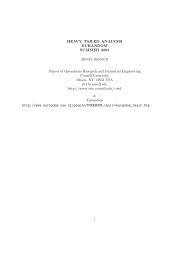
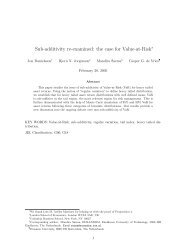
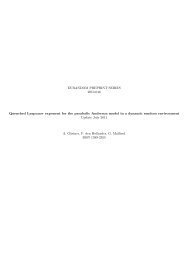
![The Contraction Method on C([0,1]) and Donsker's ... - Eurandom](https://img.yumpu.com/19554492/1/190x143/the-contraction-method-on-c01-and-donskers-eurandom.jpg?quality=85)
